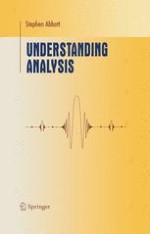2001 | OriginalPaper | Buchkapitel
Functional Limits and Continuity
verfasst von : Stephen Abbott
Erschienen in: Understanding Analysis
Verlag: Springer New York
Enthalten in: Professional Book Archive
Aktivieren Sie unsere intelligente Suche, um passende Fachinhalte oder Patente zu finden.
Wählen Sie Textabschnitte aus um mit Künstlicher Intelligenz passenden Patente zu finden. powered by
Markieren Sie Textabschnitte, um KI-gestützt weitere passende Inhalte zu finden. powered by
Although it is common practice in calculus courses to discuss continuity before differentiation, historically mathematicians’ attention to the concept of continuity came long after the derivative was in wide use. Pierre de Fermat (1601–1665) was using tangent lines to solve optimization problems as early as 1629. On the other hand, it was not until around 1820 that Cauchy, Bolzano, Weierstrass, and others began to characterize continuity in terms more rigorous than prevailing intuitive notions such as “unbroken curves” or “functions which have no jumps or gaps.” The basic reason for this two-hundred year waiting period lies in the fact that, for most of this time, the very notion of function did not really permit discontinuities. Functions were entities such as polynomials, sines, and cosines, always smooth and continuous over their relevant domains. The gradual liberation of the term function to its modern understanding a rule associating a unique output to a given input—was simultaneous with 19th century investigations into the behavior of infinite series. Extensions of the power of calculus were intimately tied to the ability to represent a function f (x) as a limit of polynomials (called a power series) or as a limit of sums of sines and cosines (called a trigonometric or Fourier series). A typical question for Cauchy and his contemporaries was whether the continuity of the limiting polynomials or trigonometric functions necessarily implied that the limit f would also be continuous.
